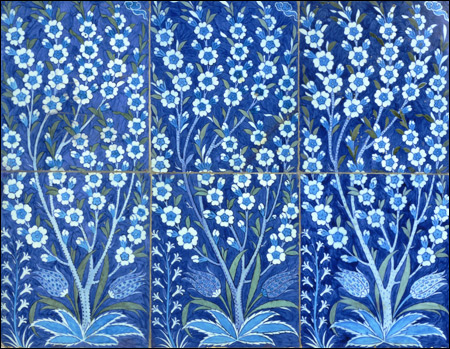
PANEL OF SIX TURKISH TILES CIRCA 1540: Islamic prohibitions against idolatry mean that abstracted pattern dominates in “Cosmophilia.”
|
It seems the Hindu god Krishna and his lover Radha were always sneaking off to some secluded moonlit spot. In an exquisitely detailed painting dubbed The Bower of Quiet Passion, the couple embrace on a bed of lotus blossoms amid a dense forest. The whole world is attuned to their dreamy mood, the lake blooming with flowers, the lush green wood, all sweet and calm and humid
Throughout the history of art there’ve been lots of paintings of ravishing ladies, from Botticelli to Leonardo da Vinci to Utamaro, and lots of naked ladies, too. But “Domains of Wonder” at the Museum of Fine Arts reminds us that till, say, Hollywood films there’s been little visual art as seductively romantic as Indian miniatures.
The exhibit showcases more than 100 Indian paintings from the 14th to the 19th century drawn from the Binney collection at the San Diego Museum of Art, which the MFA trumpets as “the largest and most important holding of South Asian painting outside of India.” The show centers on art made for Mughal leaders — Muslims from what is now Afghanistan who conquered northern India around 1525 and retained power for three centuries — and works produced for the Hindu maharajas of tributary states like Rajasthan in northwest India and the Pahari region in the western foothills of the Himalaya.
Here are royal portraits, illustrations of sacred verses, wandering ascetics, a fabled jackal who tricked other animals into making him their king, angry elephants, a princess and her companions on a marble terrace watching fireworks shimmer upon water, the bloody tumult of archers and swordsmen storming a fort. The paintings mix lavish detail (every leaf on every tree), stylization (mountains become confections of overlapping pink swirls), formal rigor (people are often rendered in profile), intimate scale, and moody color. The paint was built up in burnished layers and preserved because these pages were stowed in albums that were viewed only on special occasions.
There’s a terrific painting recounting a royal tiger hunt. The maharaja’s party travels from a misty river to a hunting blind where they lure a tiger with a tied-up bull. They shoot the tiger, but, wounded, it hides in a thicket until driven out by men with firecrackers and surrounded by swordsmen and dogs.
There are fabulous depictions of the tales of Rama — like Krishna an incarnation of the god Vishnu. Rama and his army of monkeys and bears search for his wife, Sita, who’s been kidnapped by a demon. In one scene, monkeys meet atop a mountain with a vulture who has seen the woman and the demon. In another, the demon has been defeated and the reunited couple travel home inside a glowing floating palace. Elsewhere, Krishna, assuming his true form as Vishnu, flies atop a bird creature to the mountaintop redoubt of another dastardly demon (this one’s crimes included cheating his own mother out of a pair of divine earrings) and vanquishes him.
Then there are the romantic scenes: an ascetic fainting at the beauty of a courtesan; the god Shiva plucking a flower for his lover and gently laying down with her on a tiger-skin bed. And there’s Krishna, who comes off like a rock-star ladykiller. He cavorts with a gang of topless gopis (lady cow herders) amid the lotus blossoms of a churning river. His beauty transfixes a group of gopis standing opposite him at a pond at dusk. Gopis wander in the moonlight looking for Krishna — after he disappears because he decides the women have grown too confident of his affections.
The romantic charge of Indian miniatures comes from their focus on relationships rather than on isolated beautiful people. This may trace back to a Hindu concept of romantic love as a metaphor for people’s ideal relationship with the divine. In the paintings, it plays out as furtive whispers, sultry flirtations, unrequited desires, secret liaisons, the hot thrill of new romance.
You see it most dramatically in Krishna’s relationship with his favorite gopi, Radha. At one point, Radha hears that Krishna has been unfaithful to her and refuses to see him, so he waits for her, playing her name on his flute, in “Love’s most sacred thicket.” One painting has him sitting in a flowering grove alongside a jagged river. As the old verses go: “He meditates on you without sleeping,/Muttering a series of magical prayers./He craves the rich elixir that flows from embracing your full breasts.”
Another painting collapses the narrative, putting the lovers on opposite sides of a pair of small trees symbolizing the thicket. A confidant sent by Krishna to intercede on his behalf helps Radha out of her jewelry, saying, “Leave your noisy anklets behind!/They clang like traitors in love play./Go to the darkened thicket, friend!/Hide with him in the cloak of night.”